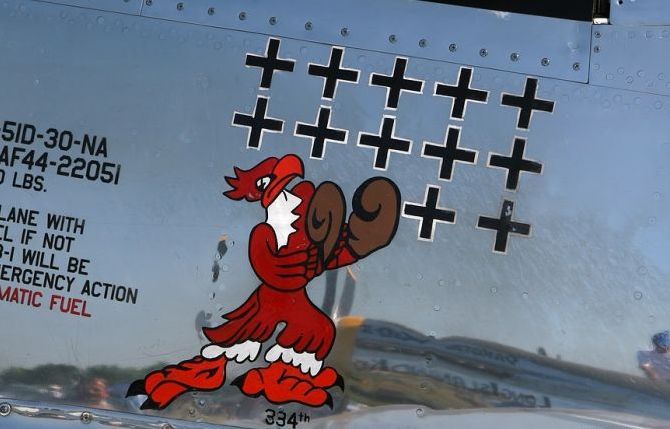|
|
Nose Art Painting Of A Military Aircraft
|
Other World War I examples included the "Hat in the Ring" of the American 94th Aero Squadron (attributed to Lt. Johnny Wentworth) and the "Kicking Mule" of the 95th Aero Squadron. This followed the official policy, established by the American Expeditionary Forces' (AEF) Chief of the Air Service, Brigadier General Benjamin Foulois, on 6 May 1918, requiring the creation of distinct, readily identifiable squadron insignia. What is perhaps the most famous of all nose art, the shark-face insignia made famous by the American Volunteer Group Flying Tigers, also first appeared in World War I on a British Sopwith Dolphin and a German Roland C.II, though often with an effect more comical than menacing. The American Volunteer Group decided to paint shark mouths on their P-40Bs after seeing a color photo in a newspaper of an No. 112 Squadron RAF P-40 fighter in North Africa with the shark mouth painted on it.
While World War I nose art was usually embellished or extravagant squadron insignia, true nose art appeared during World War II, which is considered by many observers to be the golden age of the genre, with both Axis and Allied pilots taking part. At the height of the war, nose-artists were in very high demand in the USAAF and were paid quite well for their services while AAF commanders tolerated nose art in an effort to boost aircrew morale. The U.S. Navy, by contrast, prohibited nose art, the most extravagant being limited to a few simply-lettered names, while nose art was uncommon in the RAF or RCAF.
Some nose art was commemorative or intended to honor certain people such as the B-29 Superfortress, "The Ernie Pyle".
The work was done by professional civilian artists as well as talented amateur servicemen. In 1941, for instance, the 39th Pursuit Squadron commissioned a Bell Aircraft artist to design and paint the "Cobra in the Clouds" logo on their aircraft. Perhaps the most enduring nose art of WWII was the shark-face motif, which first appeared on the Bf-110s of Luftwaffe 76th Destroyer Wing over Crete, where the twin-engined Messerschmitts outmatched the Gloster Gladiator biplanes of RAF 112 Squadron. The Commonwealth pilots were withdrawn to Egypt and refitted with Curtiss Tomahawks off the same assembly line building fighter aircraft for the AVG Flying Tigers being recruited for service in China. In November 1941, AVG pilots saw a 112 Squadron Tomahawk in an illustrated weekly and immediately adopted the shark-face motif for their own planes. This work was done by the pilots and ground crew in the field. Similarly, when in 1943 the 39th Fighter Squadron became the first American squadron in their theatre with 100 kills, they adopted the shark-face for their P-38 Lightnings. The shark-face is still used to this day, most commonly seen on the A-10 Thunderbolt II (with its gaping maw leading up to the muzzle of the aircraft's GAU-8 Avenger 30mm cannon), especially those of the 23d Fighter Group, the AVG's descendent unit, and a testament to its popularity as a form of nose art.
|
|









